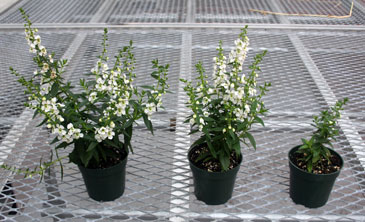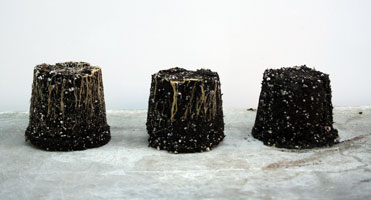6/29/2015
Improving Ethephon Drenches
Christopher J. Currey, Kenneth G. McCabe & Kellie J. Walters
Ethephon is a unique PGR due to the numerous responses it can elicit when applied to plants. When applied to plants, the ethephon generates ethylene gas, which, depending on the stage of the crop and the amount applied, can have several different effects. When ethephon is applied to fruiting crops such as ornamental peppers, fruits ripen faster, while flowering plants treated with ethephon may abort flowers and buds. Ethephon also can be used to stimulate lateral branching and improve the shape of containerized crops. Applying foliar sprays of ethephon also can inhibit stem elongation and reduce stem elongation, resulting in compact plants.
There are several methods commonly used to apply PGRs, including foliar sprays, liner dips, bulb soaks and substrate drenches. Foliar sprays are the most common method of PGRs, mostly due to our familiarity with the practice and the ease of application. However, growers are interested in providing longer growth control with more uniform results and are looking to substrate drenches to provide this. Ancymidol, flurprimidol, paclobutrazol and uniconazole are frequently applied as a substrate drench. Up until recently, ethephon has only been applied using sprays, but new research is emerging to support a new method of application.
Recent research at Cornell University, Purdue University and Michigan State University has shown that ethephon is effective at suppressing stem elongation of annual bedding plants. However, the impact of ethephon on growth and development varied among the different institutions. This variation in the impact of ethephon drenches raised the question of timing of drench applications, as some applications were made early (2 days after transplanting), while others were made when the roots had grown to the edge of the container (10 days after transplanting). Our objective was to determine how the timing of drench applications and ethephon concentration interacted to affect growth regulation.
Materials and methods
Seedling plugs of Maverick Red Geranium, Serena White Angelonia and Cora Red Vinca in 288-cell plug trays were received at Iowa State University from a commercial plug producer. Plugs were then individually transplanted into 4-in.-diameter round plastic containers filled with a commercial, soilless growing substrate comprised of sphagnum peat moss and perlite (Sunshine Mix #1, Sun Gro Horticulture).
Following planting, ethephon drench treatments commenced. Two fl. oz. of solution containing 0, 50, 100 or 200 ppm of ethephon (Collate, Fine Americas) were applied to the surface of the growing substrate 0, 5, 10, 15 or 20 days after planting.
All plants were grown in a glass-glazed greenhouse with radiant hot-water heating, fog cooling and supplemental lighting from high-pressure sodium lamps when ambient light levels were low. Additionally, plants were irrigated as needed using water supplemented with a complete, balanced, water-soluble fertilizer providing 150 ppm
nitrogen.
We recorded the date the first flower opened for each plant. Once the majority of plants of one species had flowered, we collected destructive data. Plant height was measured from the surface of the substrate to the tallest growing point and the widths at the widest point of the plant and perpendicular from that widest point were recorded. Shoots were cut at the surface of the growing substrate, individually placed into a paper bag and placed in a drying oven for three days, after which time shoots were weighed and the dry mass was recorded.
What we saw
For all three species, we observed similar trends in response to the timing and concentration of ethephon drenches. However, the magnitude of impact depended on the species and the interaction of application timing and ethephon concentration.
Across all of the species, time-to-flowering was delayed with early ethephon drenches (0 or 5 days after transplanting) and increasing ethephon concentration. For example, when a 200 ppm drench was as applied to angelonia immediately after transplanting, flowering was delayed by eight days, while flowering was only delayed by two days when plants were treated 20 days after transplanting. For geraniums, plants treated with ethephon drenches 10 days after transplanting or greater flowered at a similar time to untreated plants. However, geraniums treated at transplanting were not even budded-up by the end of the experiment and plants treated five days after transplanting had visible buds without color above the canopy of leaves.
The greater delay in flowering for plants treated with early ethephon drenches was an unexpected response. It’s recommended to avoid applying ethephon sprays later in the production cycle in order to avoid a delay in flowering, since the sprays will cause flower buds to abort. This raises the question of why later sprays, but not later drenches, affect flowering delay.
 Figure 1. Angelonia Serena White treated with (left to right) water (control), 100 ppm 10 days after transplanting and 200 ppm 0 days after transplanting
Figure 1. Angelonia Serena White treated with (left to right) water (control), 100 ppm 10 days after transplanting and 200 ppm 0 days after transplanting
The interaction of ethephon concentration and application timing affected height and width of angelonia, geranium and vinca differently (Figure 1). For angelonia and vinca, plants treated at transplanting were too small to be marketable. Alternatively, while applying ethephon 20 days after transplanting suppressed height of vinca and geranium, it didn’t affect height of angelonia. Interestingly, the later ethephon drench applications controlled the width of angelonia plants. For example, the width of plants treated with 200 ppm ethephon drenches 20 days after transplanting were about 2 in. less than untreated plants. This shorter width could be attributed to short side branches on the angelonia, which, as we noted after the experiment, resulted in less “lodging” or breaking of branches as plants were handled.
In addition to time-to-flower, height and width, ethephon drenches resulted in less root and shoot growth across concentrations and application timing. As the concentration of ethephon increased, there was less shoot and root growth for all three species (Figure 2). However, the earlier drench applications affected root growth more than the later applications. This agrees with previous work, where we observed more drastic effects on roots with earlier ethephon drenches.
 Figure 2. Root systems of Angelonia Serena White treated with drenches containing (left to right) 0, 100 or 200 ppm ethephon.
Figure 2. Root systems of Angelonia Serena White treated with drenches containing (left to right) 0, 100 or 200 ppm ethephon.
While it’s difficult to provide species-specific concentrations for different application times, this experiment is leading us to draw some preliminary conclusions about the interaction between ethephon concentrations and application timing. First, applications should not be made earlier than 10 days after transplanting. When applications are made before 10 days, flowering is delayed too much, plants are too small, and the root and shoot growth are too small for plants to be considered marketable. For applications made between 10 and 20 days after transplanting, the concentration of ethephon should increase with the time of application. For instance, a 50-ppm solution should be used for an application made 10 days after transplanting, whereas a 200-ppm solution should be used for applications made 20 days after transplanting. Clearly, more research will help refine this emerging application technique for ethephon.
Conclusions
Applying ethephon through substrate drenches is a new application strategy for this active ingredient that shows promise for controlling growth and producing high-quality plants. While no ethephon products are currently labeled for this application method, it’s something that will be changing in the near future. As always, be sure to perform in-house trials to evaluate the effectiveness of PGR treatments with your cultivars under your individual growing conditions to see what will be the most effective treatment.
GT
Christopher J. Currey (ccurrey@iastate.edu) is an Assistant Professor of Horticulture specializing in greenhouse and controlled-environment crop production, Kenneth G. McCabe (kgmccabe@iastate.edu) is a research associate and Kellie J. Walters (kelliew@iastate.edu) is a graduate student in the Department of Horticulture. The authors would like to thank Wagner Greenhouses for plant material and Fine Americas for the PGRs.